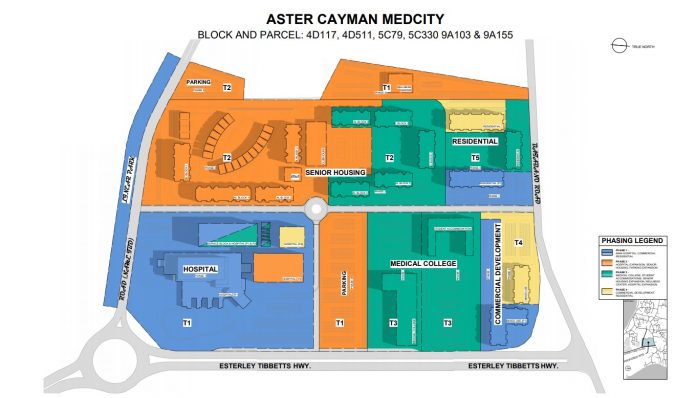Aster Caribbean Holdings has submitted a planning permission application for a $350million medical tourism hospital to be built on 40 acres in West Bay. The Central Planning Authority will hear the planning permission application for the Aster Cayman Medcity project on 12 May.
If the application is approved, the hospital campus will be built on land previously purchased from Dart. The site is located near the intersection of the Esterley Tibbetts Highway and Batabano Road in West Bay. The Aster Cayman Medcity project is being managed by Gene Thompson.
Currently, the 40-acre site is zoned as low-density residential. The planning application contains a master plan for the site, which aims to be a planned area development, or PAD. If the Central Planning Authority approves the plan, individual planning applications will be required for the individual elements of the project. These elements will be built in phases.
The initial phase of construction involves the building of a 150-bed hospital on a maximum of five storeys. Thompson explained at a press briefing last February that later building phases will expand the hospital to 500 beds. The project also proposes to provide senior care housing, a medical college, and residences. As a mixed-use development, the site will also include parking, an internal road network, landscaped areas and two lakes.
The Department of Environment, representing the National Conservation Council (NCC), and the Department of Environmental Health responded to the planning application, noting particular areas of concern and making recommendations for the review process.
A large portion of the site has already been modified and contains dyke roads used by the Mosquito Research and Control Unit, so the Department of Environment said the development project does not warrant an environmental impact assessment.
An impact on the environment is, however, possible as the Aster Cayman Medcity developer intends to remove 22 acres of mangrove trees. This intention prompted the NCC to express concern for the loss of mangrove habitat. The NCC asked that the Aster development be considered only if the CPA requests the developer to deliver “a mitigation proposal” to the NCC to ensure “‘no net loss’ of mangrove habitat”.
According to the NCC, the loss of mangroves due to development on Grand Cayman has become a major issue over the last decades. Since 1976, 72% of all mangroves on the west side of the island have been lost due to development on the western part of the island. The NCC listed the bird species impacted by the loss of mangrove habitat, like the West Indian whistling duck, and the Greater Antillean grackle, as well as the Cayman parrot, the white-crowned pigeon, and the snowy egret.
The conservation council also requested that a needs assessment take place in order to determine if a hospital of this size is needed. Three hospitals already exist on Grand Cayman: the 124-bed Cayman Islands Hospital, the 104-bed Health City, and the 18-bed Doctors Hospital. As well, Health City and Dart have proposed building plans for a 70-bed hospital to be built in Camana Bay at some point in the future.
An earlier planning application by Aster was also noted by the NCC in their response. Aster’s earlier application sought permission to clear and fill a part of the 40-acre site prior to permission being granted for the planned area development. The NCC recommended that this application be held in abeyance until the planned area development is decided, as the site may be degraded needlessly if prematurely cleared.
The conservation council also expressed concern around the matters of emissions and air quality, addressing the site plans for an incinerator for medical bio-hazardous waste. According to NCC, the planning application should include evidence of appropriate emissions regulations suited to this particular facility, as established and agreed with the Department of Environmental Health.
Some of the site’s neighbours who have objected to the development also cited the incinerator as a matter of concern. One neighbour suggested that the Caymanian government construct a single incinerator for medical waste to be shared amongst the five hospitals on a site far away from residents. To the objector, the existence of a single incinerator for all of the island’s hospitals warrants “continuous, dedicated supervision of daily maintenance and operation by qualified personnel”.
The Department of Environmental Health also responded to the planning application, recommending that more design details for each type of development be included for consideration. The Department of Environmental Health Details asserted the need for plans for the solid waste facility as well as a waste management plan for municipal solid waste and design specifications and plans for infection management that are compliant with the Public Health Infectious Waste Regulations.


